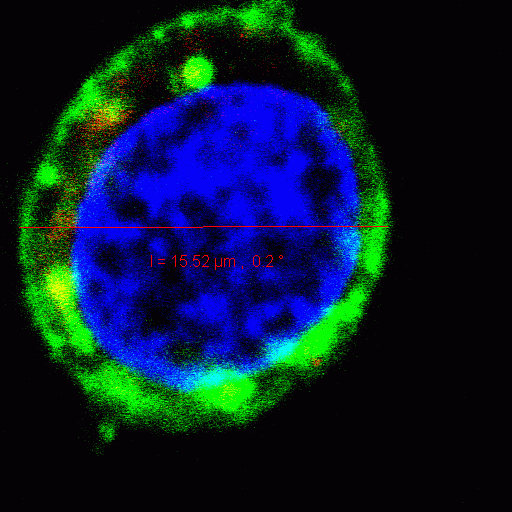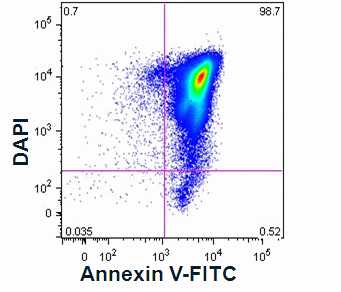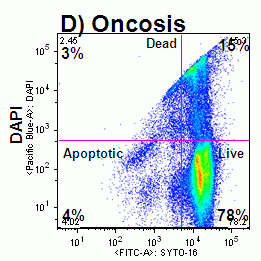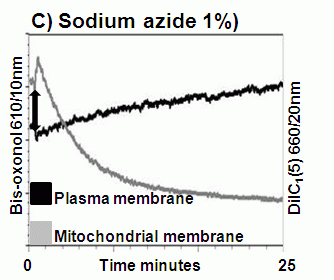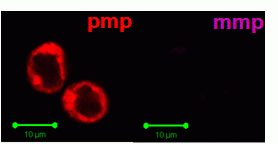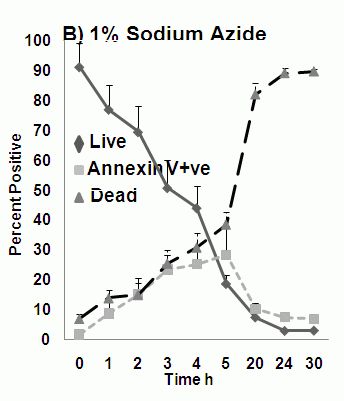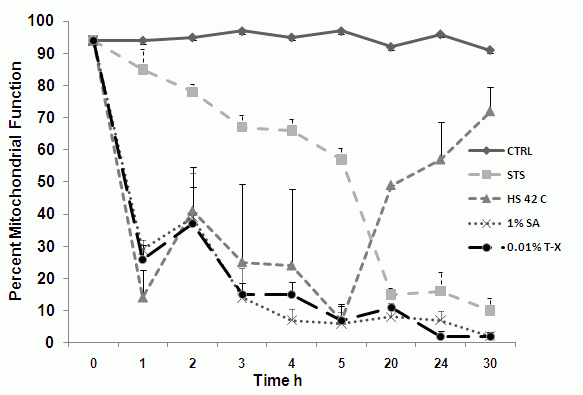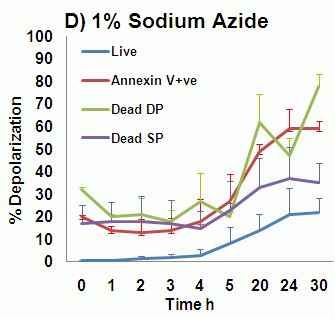Oncosis is the induction of necrosis by a nonphysiological event resulting in cell swelling as opposed apoptosis where there is cell shrinkage. Oncosis is induced by heat shock (56C or 42C), sodium azide (1% solution), Triton X-100 (0.01% solution) or drugs used to induce apoptosis at a higher concentration. Necrotic cells can be derived from the induction of apoptosis or oncosis and refers to the necrobiological events after membrane disruption. During oncosis the cell swells as does cell organelles such as mitochondria but the plasma membrane remains intact. Although it has been reported that phospholipid asymmetry is lost and the externalized phosphatidylserine can bind annexin V this is not part of the oncotic process, see figure. This is followed by the rupture of the plasma membrane during oncosis or the necrotic stage of oncosis leads to the release of proteolytic enzymes causing damage to the surrounding tissues. During apoptosis the cell shrinks in size, mitochondrial structure changes with loss of transmembrane potential, loss of asymmetry of phospholipid's and condensation of chromatin, See section on Apoptosis. This is followed by membrane blebbing and formation of apoptotic bodies and the cell is then necrotic but derived from an apoptotic process not oncosis, see figure for comparison of oncotic and apoptotic cells.
Oncosis can be differentiated from apoptosis by the use of the probe SYTO16 which not only interacts with DNA to produce a green fluorescence (530nm) but has been reported to bind to mitochondria. Even so the exact mechanism by which STYO16 measures apoptosis by loss of fluorescence in a time-dependent manner is unknown. Cells undergoing oncosis do not show this reduced fluorescence of STYO16 and such cells lose membrane integrity, as demonstrated by the use of viability dyes such as PI and DAPI (Wlodkowic et al Cytometry 2007). See figure.
Real-time membrane potential changes for the kinetic analysis of oncosis
Apoptosis is an ATP dependent process whilst oncosis is not, this fact can be used to differentiate between the two processes in a real-time manner by flow cytometric analysis of mitochondrial membrane potential by use of carbocyanine dye DiIC1(5). The different effects induced by the oncotic and apoptotic processes upon cell membranes of the cell this is especially true of the plasma membrane. The potential of the plasma membrane can be measured in a real-time manner by use of the Oxonol dye, DiCAB4 or bis-oxonol, see figure.
Oncotic agents, such as heat shock, sodium azide and Triton X-100 induce a rapid detectable reduction in mitochondrial function and plasma membrane depolarization; as shown by a rapid fall and increase in DiIC1(5) and bis-oxonol intensity respectively. Whereas induction of apoptosis results only in small insignificant changes in membrane potentials. These changes in membrane potentials during oncosis can be observed by confocal microscopy, see figure.
Time-dependent analysis of mitochondrial function during onosis
Mitochondrial function can be monitored at hourly times showing that mitochondrial function is lost in a gradual manner during apoptosis and is rapidly lost during oncosis induced by heat shock (42C), 1% sodium azide and 0.01% Triton X-100 treatments, see figure.
Annexin-V - Cell membrane changes
In normal cells, phosphatidylserine (PS) residues are found in the inner membrane of the cytoplasmic membrane. In apoptosis, the PS residues are translocated in the membrane and are externalized. In oncosis, annexin V is also externalized during the early phase of oncosis; the cells then rapidly proceed to cell death and losing membrane integrity, see figure. Oncosis is induced by heat shock (56C or 42C), sodium azide (1% solution), Triton X-100 or drugs used to induce apoptosis if used at higher concentrations can induce oncosis. Annexin-V is a specific PS-binding protein that can be used to detect apoptotic cells. Annexin-V is available conjugated to a number of different fluorochromes.
Plasma membrane potential changes during oncosis
The rapid changes in plasma membrane potential observed during the initial stages of oncosis can also be measured in a time dependent manner over a 30 hour period in a similar manner to that of annexin V binding, see figure. A higher proportion of cells undergoing oncosis show depolarization of the plasma membrane, especially cells that are dead and bind annexin V; as does annexin V binding cells, dead cells that do not bind annexin V and even live cells although these do maintain membrane integrity they have little mitochondrial function, see figure. See also the section Viability on the role of plasma membrane depolarization in phases of cell death.
- Model of plasma membrane
- Comparison of necrotic and apoptotic cell size
- Confocal microscopy of oncosis
- Comparison of oncosis and apoptosis using annexin V-FITC and DAPI
- Annexin V protocol
- Mitochondrial membrane dye protocol
- Plasma membrane dye protocol

